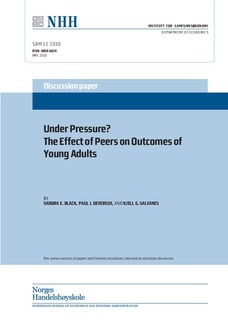| dc.description.abstract | A variety of public campaigns, including the “Just Say No” campaign of the 1980s and
1990s that encouraged teenagers to “Just Say No to Drugs”, are based on the premise that
teenagers are very susceptible to peer influences. Despite this, very little is known about
the effect of school peers on the long-run outcomes of teenagers. This is primarily due to
two factors: the absence of information on peers merged with long-run outcomes of
individuals and, equally important, the difficulty of separately identifying the role of
peers. This paper uses data on the population of Norway and idiosyncratic variation in
cohort composition within schools to examine the role of peer composition in 9th grade
on longer-run outcomes such as IQ scores at age 18, teenage childbearing, postcompulsory
schooling educational track, adult labor market status, and earnings. We find
that outcomes are influenced by the proportion of females in the grade, and these effects
differ for men and women. Other peer variables (average age, average mother’s
education) have little impact on the outcomes of teenagers. | en |
